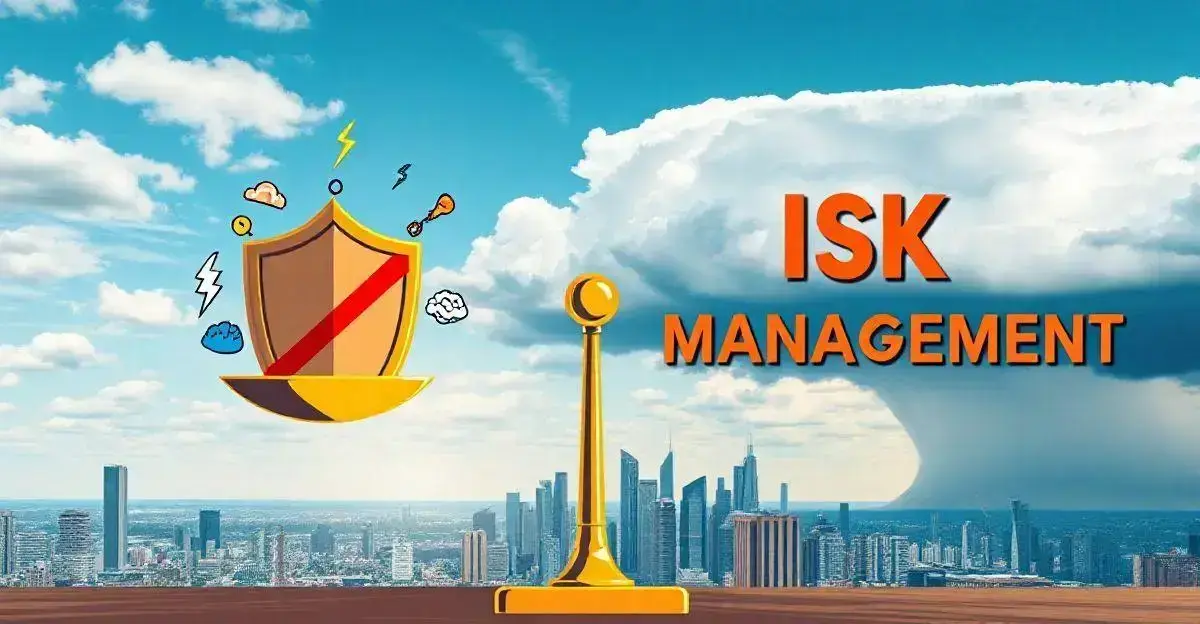In today’s fast-paced world, understanding risk business is crucial for any enterprise aiming for success.
By identifying potential risks such as financial fluctuations and market volatility, businesses can create robust strategies that not only safeguard their interests but also enhance their growth potential.
Understanding Risk in Business
Understanding risk in business is vital for every entrepreneur. Businesses face various uncertainties, from market fluctuations to operational challenges. By recognising these risks, companies can develop strategies to mitigate them effectively.
Financial risks such as fluctuations in cash flow can significantly impact operations. Similarly, regulatory risks can affect compliance and lead to potential penalties. Identifying these risks involves thorough analysis and assessment techniques to ensure proper management.
Moreover, risk awareness can pave the way for opportunities. For instance, a business that understands its market can innovate and adapt more quickly to changes in consumer behaviour. Risk management is not just about avoiding threats but also seizing opportunities for growth and expansion.
It is essential to cultivate a risk-aware culture within the organisation. Employees should be encouraged to report potential risks without fear of repercussions. Training sessions and workshops can empower staff to identify and address risks proactively.
In summary, being mindful of risk in business helps create a resilient organisation better equipped to handle challenges and pursue growth.
Importance of Risk Management

The importance of risk management in business cannot be overstated. Effective risk management helps identify potential pitfalls and provides a framework for developing strategies to mitigate these risks. Without proper management, businesses may face severe consequences such as financial losses or damaged reputations.
Risk management starts with identification. Businesses must assess internal and external factors that could pose risks. This includes operational risks, such as supply chain disruptions, and market risks, like changes in consumer preferences.
Once risks are identified, companies can implement strategies to mitigate them. This may include diversifying suppliers to reduce reliance on a single source or investing in insurance policies to protect against unforeseen events. Regular monitoring and adjustments to risk management plans are essential to stay ahead of emerging threats.
Incorporating a culture of risk awareness among employees can further enhance risk management efforts. Providing training and resources enables staff to recognise potential risks and respond effectively, fostering a proactive approach throughout the organisation.
Types of Risks Businesses Face
Businesses encounter various types of risks that can impact their operations and profitability. Understanding these risks is essential for implementing effective risk management strategies. Some common types include:
1. Financial Risks: These involve potential losses due to market fluctuations, credit risks, or currency exchange rates. Companies must manage their cash flows and investments to minimise these risks.
2. Operational Risks: These arise from internal processes, systems, or human errors. This could include supply chain disruptions or equipment failures. Identifying weak points in operations can help businesses strengthen their processes.
3. Compliance Risks: Businesses must adhere to various laws and regulations. Failing to comply can result in legal penalties and damage to reputation. Regular audits and training on relevant regulations can mitigate these risks.
4. Strategic Risks: These are related to changes in the market or competitive landscape. If a company does not adapt to shifting consumer preferences or emerging competitors, it may lose market share.
5. Reputational Risks: Negative public perception can harm a business’s brand. Managing communication and public relations effectively is crucial to protecting a company’s reputation.
By recognising these types of risks, businesses can prepare and implement strategies to reduce their impacts, ultimately ensuring long-term success.
Strategies for Mitigating Risks

Effective strategies for mitigating risks are essential for businesses aiming to minimise potential threats. These strategies help protect assets and ensure long-term success. Here are some key approaches:
1. Risk Assessment: The first step in risk mitigation is conducting a thorough risk assessment. This process involves identifying potential risks, analysing their likelihood and impact, and prioritising them accordingly. By understanding the risk landscape, businesses can allocate resources effectively.
2. Diversification: Diversifying products, services, and suppliers can reduce exposure to specific risks. For instance, a company that relies on a single supplier can face significant disruptions if that supplier experiences issues. By diversifying their supply chain, businesses can minimise this risk.
3. Implementation of Policies: Establishing clear policies and procedures can guide employees in managing risks effectively. Training staff on these policies ensures everyone is aware of their roles in maintaining a risk-free environment.
4. Insurance Coverage: Investing in appropriate insurance plans can serve as a safety net against unforeseen events. Businesses should evaluate their insurance needs regularly to ensure adequate coverage.
5. Continuous Monitoring: After implementing risk mitigation strategies, it is crucial to monitor their effectiveness. Regularly reviewing risk management plans helps businesses adapt to changing circumstances and emerging threats.
These strategies are designed to create a resilient organisation capable of navigating challenges while pursuing growth opportunities.
Case Studies of Successful Risk Management
Case studies of successful risk management provide valuable insights into how businesses can navigate challenges effectively. Many companies have implemented strategic measures to mitigate risks and achieve their goals. Here are a few notable examples:
Company A: This company faced significant financial risks due to market volatility. By diversifying their investments and conducting regular portfolio assessments, they minimized potential losses. Their proactive approach helped them maintain stability, even during economic downturns.
Company B: To address operational risks, Company B developed a comprehensive supply chain strategy. By partnering with multiple suppliers, they ensured product availability and reduced vulnerabilities associated with relying on a single source. This approach proved successful, especially during disruptions caused by natural disasters.
Company C: After encountering compliance issues, Company C established a robust internal policy framework. They provided training on regulatory requirements and conducted regular audits to ensure adherence. This commitment to compliance helped restore their reputation and reduced the likelihood of future penalties.
Company D: Facing strategic risks due to shifts in consumer behavior, this company conducted market research and adapted their product offerings accordingly. By embracing innovation and staying attuned to trends, they successfully captured new market segments.
Examining these case studies shows that effective risk management can lead to resilience and sustained success in various business environments.
Tools and Resources for Risk Assessment

Using the right tools and resources for risk assessment is essential for businesses aiming to identify and manage potential risks effectively. Here are some key tools that can help:
1. Risk Assessment Software: Various software applications are designed to streamline the risk assessment process. These tools allow businesses to analyse risks, track their potential impacts, and generate reports easily. Examples include RiskWatch and LogicManager.
2. SWOT Analysis: Conducting a SWOT analysis (Strengths, Weaknesses, Opportunities, Threats) can provide insights into a business’s internal and external risks. This framework helps businesses understand their vulnerabilities and areas where they can strengthen their position.
3. Surveys and Questionnaires: Gathering feedback from employees, customers, and stakeholders is crucial. Surveys and questionnaires enable businesses to identify potential risks related to operations, customer satisfaction, and employee engagement.
4. Industry Reports: Regularly reviewing industry reports can help businesses stay updated on trends and potential risks in their sectors. These reports often highlight emerging risks and provide insights into how others manage similar challenges.
5. Risk Management Frameworks: Adopting established frameworks, such as ISO 31000, enables businesses to structure their risk management processes systematically. These frameworks provide guidelines for identifying, assessing, and mitigating risks effectively.
Utilising these tools can enhance a company’s ability to assess risks accurately and develop actionable strategies for risk management.
Future Trends in Risk Business
The future trends in risk business are evolving rapidly as companies adapt to a dynamic environment. One significant trend is the increased use of technology for risk assessment and management. Businesses are leveraging data analytics and machine learning to predict potential risks and automate decision-making processes.
Another trend is the rise of sustainability risks. As more companies commit to environmentally friendly practices, they face new challenges related to regulatory compliance and public perception. Understanding and managing these risks are becoming crucial for maintaining a positive brand image.
Cybersecurity risks are also a growing concern. With businesses relying more on digital platforms, the threat of cyber attacks increases. Implementing robust cybersecurity measures and developing incident response plans are essential for protecting sensitive data.
Furthermore, companies are focusing on operational resilience. The ability to adapt to disruptions, whether from natural disasters or sudden market changes, is a key success factor. This involves reviewing and strengthening supply chains and workforce adaptability.
Overall, staying ahead in the risk business requires a proactive approach, embracing new technologies, and remaining aware of emerging challenges in the market.
FAQ – Frequently Asked Questions about Risk Management in Business
What is risk management?
Risk management is the process of identifying, assessing, and controlling potential risks that could negatively impact a business.
Why is risk assessment important?
Risk assessment helps businesses understand potential threats and develop strategies to mitigate them, ultimately ensuring stability and growth.
What tools can I use for risk assessment?
Tools like risk assessment software, SWOT analysis, and industry reports can help identify and manage risks effectively.
How can I ensure my business is resilient to risks?
By implementing proactive risk management strategies, diversifying operations, and maintaining a solid incident response plan.
What are some common types of business risks?
Common types of risks include financial risks, operational risks, compliance risks, strategic risks, and reputational risks.
How can technology assist in risk management?
Technology enables businesses to automate risk assessments, analyse data for trends, and respond swiftly to potential threats.
